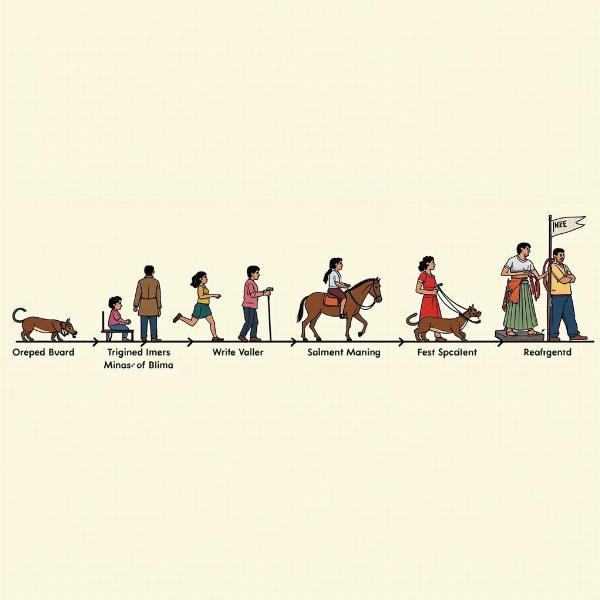Understanding the concept of “regressed meaning in Hindi” can be tricky. It involves delving into the evolution of words and how their meanings shift over time. This article explores the fascinating journey of words in Hindi, examining how cultural and historical influences contribute to semantic regression, and providing practical examples to illustrate this linguistic phenomenon.
Unraveling the Concept of Semantic Regression in Hindi
Semantic regression, simply put, is the process where a word’s meaning becomes narrower or more specialized over time. In Hindi, like any other language, words are not static entities. Their meanings are dynamic, influenced by social, cultural, and historical contexts. Sometimes, a word with a broad meaning can gradually acquire a more specific meaning, effectively “regressing” in its semantic scope. This evolution can be subtle, occurring over generations, and is often driven by changes in society and how language is used. Recognizing semantic regression is crucial for accurate understanding and translation, especially when dealing with older texts or dialects. The shift in meaning can significantly alter the interpretation of a sentence or passage.
 Illustrative Examples of Semantic Regression in Hindi
Illustrative Examples of Semantic Regression in Hindi
Historical and Cultural Influences on Word Meaning
Hindi, with its rich history and diverse influences, offers a compelling case study for semantic regression. The language has absorbed elements from Sanskrit, Persian, Arabic, and even English, each contributing to the dynamic evolution of word meanings. Historical events, social changes, and cultural shifts have all left their mark on the language. For instance, words related to social hierarchy or traditional occupations may undergo semantic regression as society evolves. Similarly, the introduction of new technologies and concepts can lead to the specialization of existing words or the creation of entirely new terms.
Examples of Regressed Meaning in Hindi
Several examples illustrate semantic regression in Hindi. Consider the word “पुत्र” (putra), which originally meant “child” but now primarily signifies “son.” Another example is “धन” (dhan), which originally meant “possession” or “wealth” in a general sense, but has come to primarily denote “money” in contemporary usage. These shifts demonstrate how words can acquire more specialized meanings over time, reflecting changing social and cultural norms.
Recognizing and Interpreting Regressed Meanings
Understanding semantic regression is essential for interpreting texts accurately, particularly historical or literary works. Recognizing these shifts can prevent misunderstandings and provide a deeper appreciation for the nuances of the language. Consulting dictionaries and etymological resources can be helpful in tracing the evolution of word meanings. Moreover, engaging with native speakers and immersing oneself in the cultural context can provide valuable insights into the subtle shifts in meaning that might not be apparent from dictionary definitions alone.
The Importance of Context in Understanding Regressed Meanings
Context plays a vital role in understanding words that have undergone semantic regression. The surrounding words, sentences, and the overall context in which a word is used can provide clues to its intended meaning. Paying close attention to the context is particularly crucial when dealing with older texts or dialects where the meanings of words might have shifted significantly over time.
Conclusion
Regressed meaning in Hindi is a fascinating aspect of language evolution, reflecting the dynamic interplay between language, culture, and history. Understanding this phenomenon is crucial for accurate interpretation and communication. By recognizing the impact of historical and cultural influences and paying close attention to context, we can gain a deeper appreciation for the richness and complexity of the Hindi language.
FAQ
- What is semantic regression? Semantic regression is the narrowing or specialization of a word’s meaning over time.
- How does semantic regression occur in Hindi? It occurs due to cultural, social, and historical influences on the language.
- Why is understanding semantic regression important? It’s crucial for accurate interpretation, especially of older texts or dialects.
- Can you give more examples of regressed meaning in Hindi? Yes, the word “नागर” (nagar) originally meant “city” in general but now often refers specifically to a town or a smaller city.
- How can I learn more about semantic change in Hindi? Consulting etymological dictionaries and engaging with native speakers can be helpful.
- Does semantic regression happen in other languages? Yes, it’s a common linguistic phenomenon observed across many languages.
- How does context help in understanding regressed meanings? Context provides clues to the intended meaning of a word, especially when its meaning has shifted over time.
Meaning-Hindi.in is your premier destination for professional Hindi translation services, catering to diverse needs, from business documents to legal texts, technical manuals, website localization, and academic papers. Our expert linguists possess a deep understanding of Hindi nuances, ensuring accurate and culturally sensitive translations. Need help with understanding the subtleties of Hindi, including semantic regression? Contact us today for a free quote! Email: [email protected], Phone: +91 11-4502-7584. Meaning-Hindi.in helps bridge the communication gap between languages and cultures.